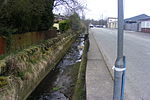Dawn Mill, Shaw
Buildings and structures demolished in 2005Demolished buildings and structures in Greater ManchesterShaw and CromptonTextile mills in the Metropolitan Borough of OldhamTextile mills owned by the Lancashire Cotton Corporation
Dawn Mill, Shaw was a cotton spinning mill in Shaw and Crompton, Oldham, Greater Manchester. It was built on the site of Shaw Mill at the "dawn" of the 20th century. Dawn Mill was equipped with mule weft spindles in 1950. It was powered by Engines named Venus and Mars, 1800 hp twin tandem compound engine by George Saxon of Manchester. It was taken over by the Lancashire Cotton Corporation in the 1930s and passed to Courtaulds in 1964. It was sold again and used by distribution company DTS Logistics for storing and distributing clothing. It was demolished in 2006 to make way for an Asda supermarket.
Excerpt from the Wikipedia article Dawn Mill, Shaw (License: CC BY-SA 3.0, Authors).Dawn Mill, Shaw
Newtown Street,
Geographical coordinates (GPS) Address Nearby Places Show on map
Geographical coordinates (GPS)
| Latitude | Longitude |
|---|---|
| N 53.5762 ° | E -2.0923 ° |
Address
Newtown Street
OL2 8NX , Shaw Side
England, United Kingdom
Open on Google Maps







